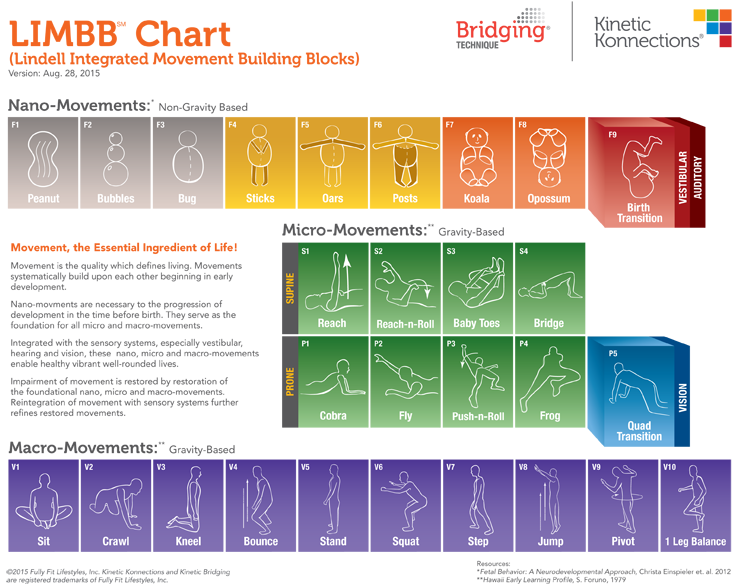Angelica’s Story: When Early Life Disruptions Shape a Lifetime of Pain
Early Life Movement Glitches — and Their Impact Years Later
Angelica’s hips had “felt wrong” for years. The discomfort became something she simply lived with — until her mom wondered if early-life movement disruptions might offer an explanation.
She suggested Angelica reach out to the Bridging® Institute to explore whether the developmental framework of Bridging might help where everything else had fallen short.
Why Look Back So Far?
Fetal movement develops in a series of predictable, layered patterns—just like infant milestones. These foundational patterns create the muscle coordination and symmetry we rely on throughout life.
But when events disrupt that early development, it’s like pulling blocks out of the base of a Jenga tower. The structure may still stand—but it’s inherently less stable.
Angelica’s early history included several such disruptors:
- Fetal substance exposure (birth mother)
- Premature birth (micro-preemie)
Each of these can interrupt critical phases of movement development in distinct ways. Let’s explore how this connects to Angelica—and to the framework used in the Bridging Technique.
The 8 Fetal Movement Building Blocks
Informed by the work of Dr. Christa Einspeiler (author of Fetal Behaviour), the Bridging Technique defines eight essential movement phases during fetal development shown in the top row of the framework. (Read a recent discussion here.)

These “nanomovements” set the stage for all future physical coordination. Here’s a quick overview, in sequence:
- Peanut: Whole-body rocking and rolling; uniform body tone
- Bubbles: Diaphragm develops—becomes internal core support
- Bug: Central spine and centerline form; arms and legs begin symmetrical movement
- Sticks: Individual limb structure gains integrity
- Oars: Arms integrate with the core (like oars on a boat)
- Posts: Legs connect to the lower core for kicking and pushing
- Koala: Twisting and flipping in fluid; responses to maternal movement
- Opossum: Head settles into mother’s pelvis; enables fine head/eye/tongue movement
Each phase must build on the one before it. If disrupted, the system doesn’t self-correct; instead it compensates, often ineffectively.
In essence, these each form the blueprint for how our bodies work. Each step supports what comes next.
What Can Disrupt These Early Movements?
The fetal movement book and research outline multiple disruptors, all of which can reduce or asymmetrically alter movement:
- Positional in utero: Breech, twins, nuchal cord
- Genetic: DNA/RNA-related structure/function delays
- Maternal health: Bedrest, fibroids, surgery, antibiotics
- Placental or amniotic: Fluid issues
- Substance exposure: Drugs, alcohol
- Medical interventions: Radiation, long hospital stays, medications
These disruptions can create movement asymmetries or coordination glitches that are not always obvious at birth — but surface later. As an older child or adult they can present as coordination problems, anxiety, or chronic pain.
How Angelica’s Story Fits In
In Angelica’s case, here’s how her known history relates to movement development and hip issues:
- Fetal substance exposure can disrupt the timing and coordination of early movements, especially during the second trimester when limb-core integration is intensifying. This results in varying levels of asymmetry and disorganization. Movements may occur, but not in a coordinated pattern.
- Prematurity (micro-preemie) meant Angelica missed some final movement integration, especially in the Opossum phase, where the head stabilizes and the neck and respiratory system finish integrating.
What we found is the movement of her core was out if synch with her legs, hence the tightness at the hips causing the ever present pain.
What We Saw — and What Changed
In her Bridging session shown on YouTube, Angelica’s assessment revealed:
- Tight, restricted lower body movement
- Very little integrated motion between legs and core
- No significant injury history, but clear movement “glitches”
With gentle support to her upper and lower body, and rhythmic rocking, the timing and coordination between her limbs began to sync. The tightness in her hips from years of compensating released as her muscles were able to learn their foundational movement skills
Angelica’s Update
Her comment after that session:
“I slept great! No leg or back pain yesterday or today!”
Developmental movement is a layered process and there is more to do. We’ll continue building up the missing pieces in future sessions.
Stay tuned for updates!
Why This Matters for You (or Your Child)
Early movement glitches are often the hidden key to pain, poor coordination, or chronic tension — especially when nothing else has worked.
If you or your child experienced any of the early disrupters listed above, it’s likely your foundational coordination is incomplete.
The good news? It can still change.

